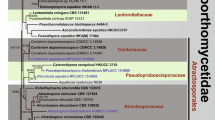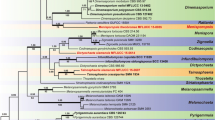Abstract
Two new genera, Atractospora and Rubellisphaeria, are described for perithecial ascomycetes occurring on decaying wood submerged in freshwater habitats. Their relationships with other morphologically similar fungi were investigated utilising four nuclear ribosomal and protein-coding loci. They are nested together with members of five orders and families and numerous genera incertae sedis in the Sordariomycetidae in a clade supported by Maximum Likelihood and Bayesian inference methods. Their closest relative is Lentomitella. Atractospora includes species characterised by dark, immersed to semi-immersed beaked ascomata lying horizontally to the host, stipitate asci with a pronounced non-amyloid apical annulus and hyaline, fusiform, septate, thick-walled ascospores with smooth or ornamented wall. Three novel species are introduced (A. decumbens, A. reticulata and A. verruculosa). A new combination for Aquaticola ellipsoidea is proposed in Atractospora based on molecular data and morphological characters. Rubellisphaeria, with a new species R. abscondita, is distinct by subhyaline to reddish brown, immersed ascomata with a lateral neck, short-stipitate asci and ellipsoidal smooth ascospores with a delayed formation of a middle septum. The sexual morph of the dematiaceous hyphomycete genus Myrmecridium was encountered for the first time on decaying wood submerged in a stream. It is nested in a strongly supported monophyletic clade of the Myrmecridiales. The novel species M. montsegurinum is described; it possesses papillate ascomata immersed beneath a clypeus with subhyaline to weakly pigmented ascomatal wall, long-stipitate asci with a non-amyloid apical annulus and three-septate, hyaline, ellipsoidal, delicately verruculose ascospores. A morphology-based key is provided to facilitate identification of species of Atractospora.







Similar content being viewed by others
References
Arzanlou M, Groenewald JZ, Gams W et al (2007) Phylogenetic and morphotaxonomic revision of Ramichloridium and allied genera. Stud Mycol 58:57–93
Cai L, Hyde KD (2007) New species of Clohiesia and Paraniesslia collected from freshwater habitats in China. Mycoscience 48:182–186
Campbell J, Shearer CA (2004) Annulusmagnus and Ascitendus, two new genera in the Annulatascaceae. Mycologia 96:822–833
Crous PW, Wingfield MJ, Guarro J et al (2015) Fungal planet description sheets: 320−370. Persoonia 34:167–266
Ferrer A, Miller AN, Sarmiento C, Shearer CA (2012) Three new genera representing novel lineages of Sordariomycetidae (Sordariomycetes, Ascomycota) from tropical freshwater habitats in Costa Rica. Mycologia 104:865–879
Gutell RR (1993) Collection of small subunit (16S- and 16S-like) ribosomal RNA structures. Nucleic Acids Res 21:3051–3054
Gutell RR, Gray MW, Schnare MN (1993) A compilation of large subunit (23S and 23S-like) ribosomal RNA structures. Nucleic Acids Res 21:3055–3074
Hall TA (1999) BioEdit 5.0.9: a user-friendly biological sequence alignment editor and analysis program for Windows 95/98/NT. Nucleic Acids Symp Ser 41:95–98
Ho WWH, Tsui CKM, Hodgkiss IJ, Hyde KD (1999) Aquaticola, a new genus of Annulatascaceae from freshwater habitats. Fungal Divers 3:87–97
Huelsenbeck JP, Ronquist F (2001) MrBayes: Bayesian inference of phylogenetic trees. Bioinformatics 17:754–755
Huhndorf SM, Greif M, Mugambi GK, Miller AN (2008) Two new genera in the Magnaporthaceae, a new addition to Ceratosphaeria and two new species of Lentomitella. Mycologia 100:940–955
Hyde KD (1992) Fungi from decaying inter-tidal fronds of Nypa fruticans, including three new genera and four new species. Bot J Linn Soc 110:95–110
Hyde KD (1995) Tropical Australasian fungi. VII. New genera and species of ascomycetes. Nova Hedwigia 61:119–140
Hyde KD, Jones EBG (1986) Marine fungi from Seychelles. II. Lanspora coronata gen. et sp. nov. from driftwood. Can J Bot 64:1581–1585
Hyde KD, Wong SW, Jones EBG (1999) Cataractispora gen. with three new freshwater lignicolous species. Mycol Res 103:1019–1031
Jaklitsch WM, Réblová M, Voglmayr H (2013) Molecular systematics of Woswasia atropurpurea gen. et sp. nov. (Sordariomycetidae), a fungicolous ascomycete with globose ascospores and holoblastic conidiogenesis. Mycologia 105:476–485
Jie C-Y, Zhou Q-X, Zhao W-AS, Jiang Y-L, Hyde KD, Mckenzie EHC, Wang Y (2013) A new Myrmecridium species from Guizhou, China. Mycotaxon 124:1–8
Larget B, Simon DL (1999) Markov Chain Monte Carlo algorithms for the Bayesian analysis of phylogenetic trees. Mol Biol Evol 16:750–759
Lee SB, Taylor JW (1990) Isolation of DNA from fungal mycelium and single spores. In: Innis MA, Gelfand DH, Snisky JJ, White TJ (eds) PCR protocols: a guide to methods and applications. Academic, San Diego
Liu F, Hu DM, Cai L (2012) Conlarium duplumascospora gen. et. sp. nov. and Jobellisia guangdongensis sp. nov. from freshwater habitats in China. Mycologia 104:1178–1186
Malloch D (1981) Moulds: their isolation, cultivation and identification. University of Toronto Press, Toronto
Mason-Gamer RJ, Kellogg EA (1996) Testing for phylogenetic conflict among molecular data sets in the tribe Triticeae (Gramineae). Syst Biol 45:524–545
Niessl G (1876) Notizen über neue und kritische Pyrenomyceten. Verh Naturforsch Ver Brünn 14:165–218
Nylander J (2008) MrModeltest2 v. 2.3 (Program for selecting DNA substitution models using PAUP*). Evolutionary Biology Centre, Uppsala
Pratibha J, Prabhugaonkar A, Hyde KD, Bhat DJ (2014) Phylogenetic placement of Bahusandhika, Cancellidium and Pseudoepicoccum (asexual Ascomycota). Phytotaxa 176:68–80
Raja HA, Campbell J, Shearer CA (2003) Freshwater ascomycetes: Cyanoannulus petersenii, a new genus and species from submerged wood. Mycotaxon 88:1–17
Rambaut A, Suchard MA, Xie D, Drummond AJ (2013) MCMC Trace analysis tool version v1.6.0. Available from http://beast.bio.ed.ac.uk/Tracer
Ranghoo VM, Hyde KD, Liew ECY, Spatafora JW (1999) Family placement of Ascotaiwania and Ascolacicola based on DNA sequences of the large subunit rRNA gene. Fungal Divers 2:159–168
Ranghoo VM, Hyde KD, Wong SW, Tsui CKM, Jones EBG (2000) Vertexicola caudatus gen. et sp. nov, and a new species of Rivulicola from submerged wood in freshwater habitats. Mycologia 92:1019–1026
Ranghoo VM, Tsui CKM, Hyde KD (2001) Brunneosporella aquatica gen. et sp. nov., Aqualignicola hyalina gen. et sp. nov., Jobellisia viridifusca sp. nov. and Porosphaerellopsis bipolaris sp. nov. (ascomycetes) from submerged wood in freshwater habitats. Mycol Res 105:625–633
Réblová M (2006) Molecular systematics of Ceratostomella sensu lato and morphologically similar fungi. Mycologia 98:63–93
Réblová M (2007) Barbatosphaeria gen. et comb. nov., a new genus for Calosphaeria barbirostris. Mycologia 99:723–732
Réblová M (2013) Two taxonomic novelties in the Sordariomycetidae: Ceratolenta caudata gen. et sp. nov. and Platytrachelon abietis gen. et comb. nov. for Ceratosphaeria abietis. Mycologia 105:462–475
Réblová M, Réblová K (2013) RNA secondary structure, an important bioinformatics tool to enhance multiple sequence alignment: a case study (Sordariomycetes, Fungi). Mycol Prog 12:305–319
Réblová M, Seifert KA (2004) Cryptadelphia (Trichosphaeriales), a new genus for holomorphs with Brachysporium anamorphs and clarification of the taxonomic status of Wallrothiella. Mycologia 96:343–367
Réblová M, Šťepánek V (2009) New fungal genera, Tectonidula gen. nov. for Calosphaeria-like fungi with holoblastic-denticulate conidiogenesis and Natantiella gen. nov. for three species segregated from Ceratostomella. Mycol Res 113:991–1002
Réblová M, Gams W, Seifert KA (2011) Monilochaetes and allied genera of the Glomerellales, and a reconsideration of families in the Microascales. Stud Mycol 68:163–191
Réblová M, Štěpánek V, Schumacher RK (2014) Xylochrysis lucida gen. et sp. nov., a new lignicolous ascomycete (Sordariomycetidae) with holoblastic conidiogenesis. Mycologia 106:564–572
Shenoy BD, Jeewon R, Wu WP, Bhat DJ, Hyde KD (2006) Ribosomal and RPB2 DNA sequence analyses suggest that Sporidesmium and morphologically similar genera are polyphyletic. Mycol Res 110:916–928
Shenoy BD, Jeewon R, Wang HK, Amandeep K, Ho WH, Bhat DJ, Crous PW, Hyde KD (2010) Sequence data reveals phylogenetic affinities of fungal anamorphs Bahusutrabeeja, Diplococcium, Natarajania, Paliphora, Polyschema, Rattania and Spadicoides. Fungal Divers 44:161–169
Stamatakis A (2006) RAxML-VI-HPC: maximum likelihood-based phylogenetic analyses with thousands of taxa and mixed models. Bioinformatics 22:2688–2690
Stamatakis A, Ludwig T, Meier H (2005) RAxML-III: a fast program for maximum likelihood-based inference of large phylogenetic trees. Bioinformatics 21:456–463
Tilak ST, Kale SB (1970) Contribution to our knowledge of Ascomycetes of India XXIV. Sydowia 24:81–88
Tsui CKM, Hyde KD, Hodgkiss IJ (1998) A new species of Clohiesia from Hong Kong. Mycoscience 39:257–259
Tsui CKM, Hodgkiss IJ, Hyde KD (2003) Three new species of Aquaticola (Ascomycetes) from tropical freshwater habitats. Nova Hedwigia 77:161–168
von Arx JA, Müller E (1954) Die Gattungen der amerosporen Pyrenomyceten. Beitr Kryptogamenflora Schweiz 11:1–434
von Höhnel F (1905) Mykologische Fragmente CVI–CXVII. Ann Mycol 3:548–560
Wong SW, Hyde KD, Jones EBG (1999) Ultrastructural studies of freshwater ascomycetes Fluminicola bipolaris gen. et sp. nov. Fungal Divers 2:189–197
Acknowledgments
This work was supported by the Czech Science Foundation (GA CR 506/12/0038; www.gacr.cz). Additional support was provided to M.R. by a long-term research development project of the Institute of Botany, Academy of Sciences (RVO 67985939); VŠ was funded by a long-term research development project of the Institute of Microbiology, Academy of Sciences (RVO 61388971). We wish to thank Carol Shearer, who kindly examined the material and permanent slides of A. hyalomura R38-1 deposited in the ILLS herbarium and for her valuable comments on Aquaticola, and to Steve Zelski who shared with us unpublished sequence data of A. hyalomura. We thank Walter Gams for reading the manuscript and for his helpful editorial suggestions.
Author information
Authors and Affiliations
Corresponding author
Additional information
Section Editor: Franz Oberwinkler
Rights and permissions
About this article
Cite this article
Réblová, M., Fournier, J. & Štěpánek, V. Two new lineages of aquatic ascomycetes: Atractospora gen. nov. and Rubellisphaeria gen. et sp. nov., and a sexual morph of Myrmecridium montsegurinum sp. nov.. Mycol Progress 15, 21 (2016). https://doi.org/10.1007/s11557-016-1166-z
Received:
Revised:
Accepted:
Published:
DOI: https://doi.org/10.1007/s11557-016-1166-z




